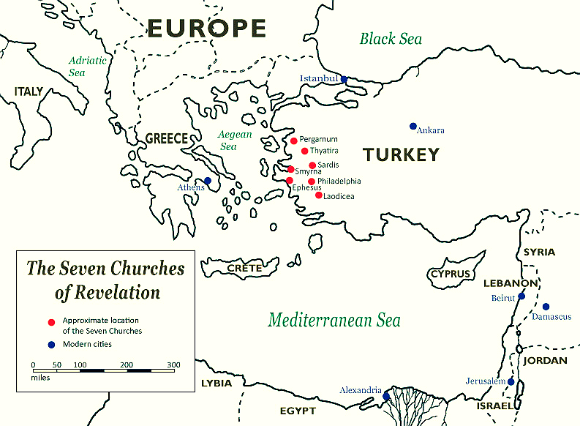Seven churches in Revelation are literal churches from the first century AD. However, the seven churches in Revelation also have spiritual significance for churches and believers today. Indeed, the primary purpose for John writing his letters to the seven churches was to deliver Christ’s “report card” for the churches of that time. However, a second purpose for John’s inspired writings was to describe seven types of churches (and individual believers) that would surface time and again throughout history. These short i-letters to the seven churches of Revelation act as quick and poignant reminders to those who call themselves “followers of Christ.”
The Seven churches in Revelation refer to seven literal churches described in Revelation: Chapters 2 and 3. These early Christian churches were located in Asia Minor(Present-day Turkey) during the era of the Roman Empire. Although the actual churches ceased to thrive in the centuries of (Muslim control after the Romans, the archaeological remains of all seven locations currently exist in present-day Turkey.
The Seven churches in Revelation are located in western Asia Minor (Present-day Turkey), accessible by way of the Aegean Sea and the ancient trade routes between the West and East. For various reasons, whether trade, military, or pure hedonism, these cities were major cultural hubs throughout history. During the first few centuries after Jesus Christ, these Roman-controlled cities were also important in early Christianity. Here are the seven churches of Revelation as described by the writer John in the late first century AD:
- Ephesus ; The desirable church that left its first love (Revelation 2:1-7). Ephesus was the influential capital city of Asia Minor on the Aegean Sea. Ephesus is now known for its huge metropolis of ancient streets, arches and ruins.second most visited place in Turkey after istanbul Sultanahmet district-Old town.
- Smyrna ; The persecuted church that suffered poverty and martyrdom (Revelation 2:8-11). Smyrna was located north of Ephesus in a powerful trading position on the Aegean Sea known for its harbors, commerce, and marketplaces. The primary ruins of Smyrna are located in the modern Turkish city of lzmir(3rd biggest city).
- Pergamum ; The worldly church that mixed doctrines and needed to repent (Rev. 2:12-17). Pergamum is located on the plains and foothills along the Caicus River in Western Turkey. It was considered a major city in Asia Minor since the 3rd century BC, and became a Greek and Roman hub for temple worship.
- Thyatira ; The false church that followed a seductive prophetess (Rev. 2:18-29). Thyatira is located in western Asia Minor about 42 miles inland from the Aegean Sea. The ancient city was known for its textiles and dyeing trade, and is now known as Akhisar-town of Manisa.
- Sardis ; The “dead” church that fell asleep (Revelation 3:1-6). Sardis is located on the banks of the Pactolus River in western Asia Minor, 60 miles inland from Ephesus and Smyrna. Popular ruins include the decadent temples and bath house complexes.
- Philadelphia ; The church of brotherly love that endures patiently (Revelation 3:7-13). Philadelphia is located on the Cogamis River in western Asia Minor, about 80 miles east of Smyrna. Philadelphia was known for its variety of temples and worship centers.
- Laodicea ; The “lukewarm” church with a faith that’s neither hot nor cold (Rev. 3:14-22). Laodicea is located in the Lycus River Valley of western Asia Minor, a primary trade route between the cultures of the West and East. Laodicea was known as a primary hub for the Roman aqueduct system.


